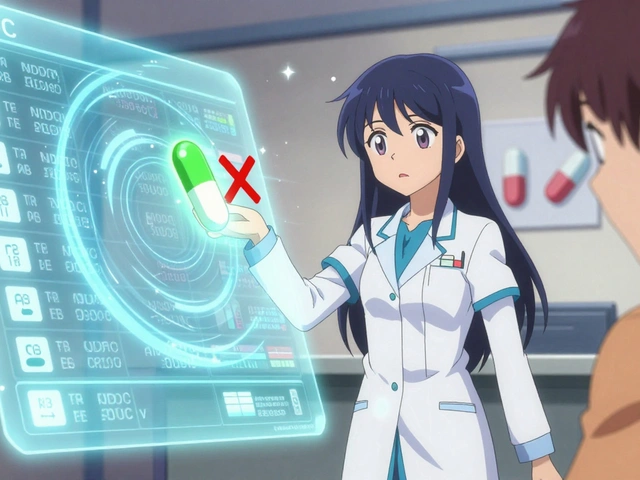When you switch from a brand-name drug to a generic version, most people don’t notice a thing. That’s by design. Generics are required to work the same way, deliver the same amount of active ingredient, and produce the same clinical results as the original. But for some, even a small change can trigger unexpected effects. That’s why monitoring your health after switching to generics isn’t just a good idea-it’s essential for certain medications.
Why Some People Notice Differences
Generic drugs aren’t copies. They’re exact matches in active ingredients, strength, and how they’re taken. The FDA requires them to meet the same strict standards as brand-name drugs. But there’s one key difference: the inactive ingredients. Things like dyes, fillers, and coatings can vary between manufacturers. For most people, these don’t matter. But if you’re sensitive to certain additives-or if you’re taking a drug with a narrow therapeutic index-those small changes can make a real difference. Drugs like warfarin, levothyroxine, lamotrigine, and some epilepsy or heart medications fall into this category. They work within a very tight range. Too little, and the condition isn’t controlled. Too much, and you risk serious side effects. That’s why the American Heart Association and the FDA both recommend extra caution when switching these types of drugs.What to Track After the Switch
You don’t need to panic. But you should pay attention. Here’s what to monitor, depending on your condition:- Thyroid medication (like levothyroxine): Watch for fatigue, weight changes, heart palpitations, or mood swings. Get a TSH blood test at 4-6 weeks after switching. Many patients report feeling off after a switch-even if lab numbers look fine.
- Antiseizure drugs (like lamotrigine or phenytoin): Keep a seizure diary. Note frequency, duration, and intensity. Even one extra seizure in two weeks is a red flag.
- Blood thinners (like warfarin): Check your INR levels at 7 days and again at 30 days. A shift of more than 0.5 from your baseline can mean you need a dose adjustment.
- Diabetes medications: Track your fasting blood sugar and HbA1c. A rise of more than 0.5% at the 8-week mark suggests you may need to switch back.
- Antidepressants (like bupropion): Watch for changes in mood, sleep, or anxiety. Some patients report feeling emotionally flat or more irritable after switching.
- Blood pressure or heart meds: Monitor your readings at home daily for the first two weeks. If your systolic number jumps by 15 points or more, call your doctor.
Don’t wait for symptoms to get bad. Track early. Use a notebook, a phone app, or even a simple spreadsheet. Write down your dose time, how you feel, and any new symptoms. This record will help your doctor decide if the generic is working-or if you need to go back.
How to Verify You Got the Right Generic
Not all generics are made the same. Different companies make the same drug, and their formulations can vary slightly. That’s why checking the National Drug Code (NDC) on your pill bottle matters. When you pick up your prescription, look at the label. The NDC is a 10- or 11-digit number. If it’s different from your last refill-even if the name is the same-it’s a different manufacturer. That’s normal. But if you’ve switched before and felt worse, ask your pharmacist: “Is this the same maker as last time?” If they say no, you can request the previous version, especially if you’ve had issues before. The FDA’s Orange Book lists which generics are rated as therapeutically equivalent to brand-name drugs. You can ask your pharmacist to check it. If a drug is marked as “AB” rated, it’s considered interchangeable. If it’s “BX,” that means there’s not enough data to confirm equivalence-rare, but it happens.When to Call Your Doctor
You don’t need to call at the first sign of a headache. But if you notice any of these, reach out:- New or worsening side effects that weren’t there before
- Loss of symptom control (seizures, high blood pressure, uncontrolled blood sugar)
- Physical changes like rash, swelling, or unusual bruising
- Feeling “off” for more than 10-14 days
Doctors often assume generics are seamless. But if you report a problem, they’ll take it seriously. A 2021 JAMA study showed that patients who spoke up about changes after switching were more likely to get their original medication restored-especially for drugs like levothyroxine and lamotrigine.
What to Do If You Think It’s Not Working
If you’re sure the generic isn’t working right, don’t just stop taking it. That’s dangerous. Instead:- Document everything: dates, symptoms, doses, lab results.
- Ask your doctor for a letter explaining why you need the brand-name version. Some insurance plans will cover it if there’s medical justification.
- If your doctor agrees, they can write “Dispense as Written” or “Do Not Substitute” on the prescription.
- If you’re still unsure, ask for a 30-day trial of the original brand to compare side by side.
Most people don’t need to switch back. But if you’re one of the small group who does, you’re not alone. The FDA received over 1,200 reports in 2022 about possible therapeutic issues with generics. Only 17 were confirmed as true cases of inequivalence. But those 17 mattered-to the people affected.

How to Report Problems
If you think a generic drug caused a problem, report it. Not just to your doctor-to the FDA. Their MedWatch system is the main way they track safety issues after drugs hit the market. You can file a report online at www.fda.gov/medwatch or call 1-800-FDA-1088. Be ready with:- The name of the drug (brand and generic)
- The NDC number from the bottle
- The lot number (usually on the label)
- When you started taking it
- What symptoms you had
The FDA reviews every report. If multiple people report the same issue with the same batch, they can pull it from the market. Your report could help someone else avoid a bad reaction.
What the Data Really Shows
Let’s be clear: generics are safe. 92% of patients who switch report no difference. In large studies, they perform just as well as brand-name drugs. The FDA has approved over 16,000 generic products. They’re used by millions every day. But the 8% who do notice something? Their experience matters. For those taking narrow-therapeutic-index drugs, monitoring isn’t optional. It’s part of managing your health. The goal isn’t to scare you off generics-it’s to help you spot the rare cases where a switch doesn’t go smoothly.Generic drugs save the U.S. healthcare system over $370 billion a year. That’s huge. But savings shouldn’t come at the cost of your health. If you feel different after switching, trust yourself. Track it. Talk to your doctor. Report it if needed. You’re not being difficult-you’re being smart.
Are generic drugs as effective as brand-name drugs?
Yes, for the vast majority of people and medications. The FDA requires generics to prove they deliver the same amount of active ingredient at the same rate as the brand-name version. Studies show they work just as well for most conditions. But for a small number of drugs-like levothyroxine, warfarin, or epilepsy meds-some patients may notice differences due to inactive ingredients or individual sensitivity.
How long should I monitor my health after switching to a generic?
For most medications, monitor for at least 30 days. For drugs with a narrow therapeutic index-like thyroid, heart, or seizure meds-monitor for 60 to 90 days. Schedule follow-up lab tests at 4-6 weeks. If you feel fine after 30 days and your numbers are stable, you’re likely good to go. But if symptoms appear or worsen, don’t wait-see your doctor.
Can I switch back to the brand-name drug if I don’t feel right?
Yes. Talk to your doctor first. They can write a prescription that says “Dispense as Written” or “Do Not Substitute.” Some insurance plans will cover the brand-name version if there’s documented medical need. Keep a record of your symptoms and lab results to support your request.
Why do some generics look different from others?
By law, generics can’t look exactly like the brand-name drug. So color, shape, size, and markings may vary between manufacturers. That’s normal. But if the pill looks different from your last refill and you’ve had issues before, ask your pharmacist if it’s the same maker. Different manufacturers can use different inactive ingredients, which sometimes affect how you feel.
Which generic drugs require the most monitoring?
Drugs with a narrow therapeutic index need the closest monitoring. These include levothyroxine (thyroid), warfarin (blood thinner), lamotrigine and phenytoin (anti-seizure), digoxin (heart), and some antidepressants like bupropion. Even small changes in blood levels can affect how well they work or cause side effects. Always check with your doctor before switching these.
How do I know if my pharmacy substituted my prescription?
Check the label. The generic name will be listed, but the NDC number (a 10- or 11-digit code) tells you who made it. If it’s different from your last refill, you got a different manufacturer’s version. You can also ask your pharmacist directly: “Was this substituted?” You have the right to ask for the original brand if you’ve had problems before.
Is it safe to switch between different generic brands?
It’s generally safe, but not always risk-free. For most drugs, switching between generics won’t cause issues. But if you’re on a narrow-therapeutic-index drug, switching manufacturers-even between two generics-can trigger changes. Stick with one manufacturer if you’ve found one that works well for you. If you must switch, monitor closely and check in with your doctor.
Next Steps for Your Health
If you’re switching to a generic today, here’s your simple action plan:- Write down the name of your drug-both brand and generic.
- Find the NDC and lot number on the bottle.
- Start tracking symptoms or key health numbers (blood pressure, glucose, seizure logs, etc.) daily for the first two weeks.
- Schedule a follow-up with your doctor at 4 weeks if you’re on a high-risk medication.
- If anything feels off, don’t ignore it. Call your doctor. Report it to the FDA.
Generics are a smart, cost-saving choice. But your health isn’t a number on a balance sheet. Pay attention. Speak up. Stay in control. You’ve earned that right.



satya pradeep
November 17, 2025 AT 23:10Been on generic levothyroxine for 3 years now. First switch had me crashing hard-fatigue, brain fog, heart racing. Got my doc to check TSH, was off by 2 points. Switched back to the old maker, felt human again. Don’t let anyone tell you it’s all in your head. The fillers matter. Write down your symptoms. Keep the bottle. NDC number is your friend.
kora ortiz
November 18, 2025 AT 20:03You’re not crazy if you feel different after switching. Track it. Document it. Talk to your doctor. Your health isn’t a cost-cutting experiment. You’ve earned the right to feel like yourself.
Prem Hungry
November 20, 2025 AT 11:12As a pharmacist in rural India, I see this every day. Patients come in saying, ‘This pill makes me dizzy.’ We check the NDC-different maker. Same generic, different binder. Some folks are sensitive to corn starch. Others to dye. We keep a log of what works for who. If they say it’s not right, we listen. No judgment. Just care.
Leslie Douglas-Churchwell
November 22, 2025 AT 04:07Big Pharma and the FDA are in cahoots. They want you to believe generics are ‘just as good’ so they can sell you poison pills with talc and plasticizers. That’s why your thyroid meds make you feel like a zombie. The ‘AB’ rating? A joke. The FDA gets funding from drug companies. Read the fine print. The inactive ingredients? They’re not inert. They’re engineered to keep you dependent. Fight back. Demand the brand. Or better yet-go herbal.
shubham seth
November 23, 2025 AT 15:49Let’s be real-generics are the pharmaceutical equivalent of buying a knockoff sneaker. Looks the same, walks the same, but falls apart after three months. I switched my lamotrigine and had a seizure I hadn’t had in 4 years. The bottle said ‘Teva’ last time, now it’s ‘Aurobindo.’ Same name, different soul. I’m not mad-I’m just done playing Russian roulette with my brain.
Jeremy Hernandez
November 24, 2025 AT 04:54People who say they ‘feel different’ after switching generics are just lazy. If your body can’t handle a $2 pill instead of a $200 one, maybe you’re not cut out for modern medicine. My cousin takes warfarin on generic and runs marathons. You’re not special. Stop whining.
Kyle Swatt
November 24, 2025 AT 11:20I used to think generics were just cheaper versions of the same thing. Then I switched my bupropion and spent two weeks feeling like a ghost. Not depressed. Not anxious. Just… empty. Like someone turned down the volume on my soul. My doc laughed at first. Then I showed him my journal. He ordered the brand back. Turns out, it’s not about the active ingredient. It’s about the whole damn package. The coating. The filler. The way it dissolves. Your body remembers. Don’t ignore it.
Elia DOnald Maluleke
November 25, 2025 AT 01:52It is not the drug that changes, but the vessel that carries it. The active principle remains unchanged, yes-but the soul of the medicine, the silent partners in its delivery, the inert yet influential companions-these are the unseen architects of our well-being. To dismiss the variance in fillers as trivial is to mistake the map for the territory. The body does not reason; it feels. And what it feels, it remembers. Let us not reduce healing to a ledger, but honor it as a sacred dance between chemistry and consciousness.
Bill Machi
November 26, 2025 AT 15:33These anecdotal horror stories are why America’s healthcare system is collapsing. People think they’re doctors now because they read a blog. The FDA has reviewed over 16,000 generics. 92% work fine. If you’re in the 8%, fine-go back to the brand. But don’t turn your personal experience into a national crisis. Stop being emotional vampires and start trusting science.
Tarryne Rolle
November 27, 2025 AT 15:23So let me get this straight-you’re saying if a pill looks different, and you feel weird, you should blame the filler? What about the fact that you’re just anxious about change? That you’re conditioned to believe brand-name equals better? That’s not medicine. That’s placebo worship dressed up as science. The real issue isn’t the generic. It’s your inability to let go of the myth of superiority.